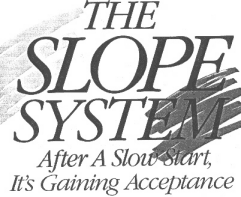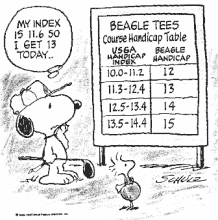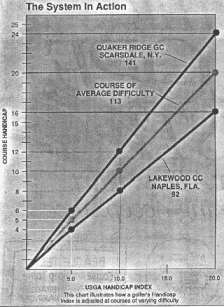The Slope System
By Tom Dellner

Ask your club professional to explain the USGA Slope System and you'll hear him assume the tone of a weary sixth-grade teacher trying to explain the New Math. Or study the relief in his eyes as he reaches for one of the many pamphlets or brochures on the subject, published by the USGA or local golf associations.
There is something in this new handicapping system that makes it inherently difficult to explain and, as a result, hard to understand. Maybe it's the graphs and tables used to illustrate the system's principles. They look like they could have been lifted from the pages of an advanced economics textbook. Maybe it's in the name. One local golf association director speaks of baffled golfers wondering how their course could have a high Slope Rating when it is "really very flat."
Don't let any of the technical jargon fool you. The concepts behind Slope are really simple, and they provide an effective solution to what was determined to be the single largest bug in the USGA's Handicapping System: The portability problem.
The portability problem occurs whenever someone plays golf away from his home course. If his USGA Handicap was earned on a difficult course, he will have an unfair advantage when he competes against a player who carries the same handicap at an easier course. A 15-handicapper from Pine Valley is just not the same golfer as a 15-handicapper from Top O' The Heather Municipal.
One of the greatest misconceptions faced by proponents of Slope is the notion that the portability problem is alleviated by adjusting handicaps according to course rating. The course rating accurately measures each course's relative difficulty for a scratch golfer. As a golfer's handicap rises, however, the course rating becomes increasingly inaccurate. At handicaps of 20 or more, the discrepancy can add up "to a difference of 12 strokes or more," says Dean Knuth, the USGA's Director of Handicapping.
That's something the bogey golfer already knows. He looks at a course much differently from a par shooter. What may look like trouble off the tee to a long-hitting scratch golfer may be completely out of reach for a 20-handicapper. While a particular pond might not bother the par shooter, it might take on ocean-like proportions to a poorer golfer.
Under the Slope System, each course is re-rar.ed through the eyes of the bogey golfer. This results in the Slope Rating, which is different for each set of tees and ranges from 55'for a very easy course to 153 for Pine Valley, the nation's toughest.
Using the USGA Slope Rating and your scores, your Handicap Index is computed. This number, carried to a decimal point, represents a player's ability on a course of average difficulty. You do not play off this number. Instead, you use it at every course you play, including your home course, to determine your Course Handicap, which is the number you will play from. If the course is of above average difficulty (rated higher than 113) you will gain strokes; if it has a rating under 113, you'll lose strokes.

This sounds much more difficult than it really is. All a player must do is remember his Handicap Index. Each course that has been re-rated for Slope has a Course Handicap Table that gives your Course Handicap from whatever set of tees you're playing.
Since Slope was refined into a workable form in 1982, implementation of the system has increased exponentially. The Colorado Golf Association pioneered Slope, re-rating all 110 of its courses in 1982 and putting the system in use the following year. The results were carefully documented. All "away" scores were recorded and analyzed, and the results showed that. the average error in handicapping was reduced from three strokes to six-tcnths of a stroke. The range of scores at handicap tournaments tightened, and enthusiasm for these events grew. Some tournaments reported entries doubling.
News of Colorado's success spread to other associations. In '83, five more associations Slope-rated their courses. By '85 the number had jumped to 20, and then to 65 in '87. Currently, 85 of the 92 golf associations nationwide have adapted the Slope System. Of the nation's 12,000 courses, 10,000 have been re-rated and 3 million golfers have a Handicap Index.
"The amazing thing about it," Knuth says, "is that the system has completely sold itself. We've never made any effort to market Slope."
Despite these impressive statistics, Slope is not problem-free. The largest stumbling block so far has been the enormous task of educating players. According to USGA figures, the average age of the American golfer is 58, and he has been playing for 30 years. That's three decades of carrying one decimal-free handicap number, and it's tough for such a golfer to restructure his concept of the handicapping system � especially in a sport as deep-rooted in tradition as golf.
Complicating this problem are the regions that have not re-rated their courses. If a course has not been given a Slope Rating, its players have no Index. What does a club pro, a tournament director or handicap committee do with these players? The answer varies by association and tournament.
Many tournament directors require that entrants must have an Index; others have allowed golfers to play off their home-course handicaps. One event that followed this policy was the National Hole-in-One Tournament, a 36-hole net-stroke event held last January. Even though 65 percent of the entrants had an Index, seven of the eight flights were won by the 35 percent who played off their home-course (non-Slope) handicap. Although this statistic is, in itself, inconclusive, it has many handicap directors shaking their heads.
The Dupont World Amateur Handicap Championship is the largest handicap championship in the country, with a 2,000-entrant limit. Given the size of the field, it's no surprise that the tournament has had a few problems with "questionable" handicaps. Although tournament director Bob Mazzone and his staff use a thorough checking system to weed out sandbaggers, he is quick to admit that "there is only so much you can do. With the numbers we deal with, it's a logistical nightmare."
This year, the event is going to Slope for the first time, and is considering several options for dealing with players without an index. Among these is the "90 percent rule," a system developed by the Wisconsin State Golf Association that accepts only 90 percent of a home-course handicap. A 20-handicapper who has no Index, for example, must play to an 18.
It looks like tournament administrators and club pros won't have to tolerate this handicap imbroglio much longer. The USGA has adopted a policy whereby it will send an authorized rating team to any course in the regions where Slope-rating has been "incomplete or severely delayed" to Slope-rate that course for a nominal fee. And the Northern and Southern California Golf Associations (the state has the largest amount of courses not rated for Slope) announced in February that they will begin re-rating courses and have Slope in effect state-wide by January 1990.

This chart shows how the Handicap Indexes of three golfers of varying ability are adjusted at different courses. The best player (yellow), with an Index of 5.0, is affected the least. When playing at a tough course like Quaker Ridge, he gains a stroke; when playing an easier layout, Lakewood, he loses a stroke and must play to a four. The effect is much more dramatic for the poorer player (green). His Index, 20.0, translates to a Course Handicap of 24 when playing Quaker Ridge, and drops to a 16 at Lakewood. The player with the Index of 10.0 (orange) will have his handicap adjusted by two strokes at either course. The only time a golfer plays to his Index is at a course of average difficulty (Slope Rating 113).
|






